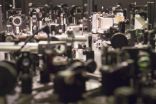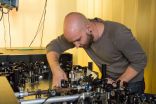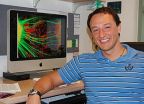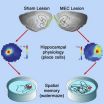(Press-News.org) This news release is available in German.
X-rays are widely used in medicine and in materials science. To take a picture of a broken bone, it is enough to create a continuous flux of X-ray photons, but in order to study time-dependent phenomena on very short timescales, short X-ray pulses are required. One possibility to create short hard X-ray pulses is hitting a metal target with laser pulses. The laser rips electrons out of the atoms and makes them emit X-ray radiation. Electrical engineers at the Vienna University of Technology (TU Wien) together with researchers from Berlin have drastically increased the flux of X-ray photons using a newly developed mid-infrared laser system. This new table-top X-ray source will allow more accurate measurements in many fields of research.
Long Waves and Short Waves
Hard x-ray radiation is light with a wavelength in the range of picometers - much shorter than the wavelength of visible light. But in order to create this extremely short wave radiation, Professor Andrius Baltuska's team (Photonics Institute, Electrical Engineering, TU Wien) starts out with a quite different kind of light. They created a high-intensity infrared laser system with a wavelength of 4 micrometers - which is a wavelength much longer than visible light.
The mid-infrared light emitted by the laser hits a copper plate. The intensity of the laser light is so high that electrons are ripped out of the atoms. The laser field turns them around, accelerates them and eventually makes them hit the copper again at very high energies. During this impact of the electrons returning to the copper plate, X-ray radiation is emitted.
"The flux of the x-ray radiation depends on the wavelength of the laser", says Skirmantas Alisauskas (TU Wien). "If the laser wavelength is long, then every electron spends a lot of time in the laser field before it returns to the copper atoms. It has more time to gain energy and hits the copper plate even harder."
Building a New Kind of Laser
This is why the scientists have focussed their attention on building long-wavelenth laser systems. "Previously, this experiment was done with a common 0.8 micrometer laser. The wavelength of our laser pulses is five times as long, which translates into a 25 times higher x-ray flux", says Skirmantas Alisauskas. Each laser pulse leads to one billion x-ray photons, emitted into all directions.
Creating this laser light was a big technological challenge. "Building lasers with such long wavelengths is hard, but the main problem was making the laser light intense enough", says Alisauskas. "At this wavelength, this is the most intense laser light in the world. But we want to go even further in the near future."
More Pulses per Second
The team is planning to go to even longer wavelengths, and they are trying to increase the rate at which the laser can produce light pulses. "At the moment, we have a repetition rate of 20 laser pulses per second. That is perfectly fine for a proof of principle, but for technological applications we need to increase that - and we already have a few good ideas of how to do this", says Prof. Andrius Baltuska.
X-rays are used whenever the atomic structure of materials has to be investigated. As the new x-ray source does not produce a continuous beam but short pulses, it can be used for time-resolved measurements.
INFORMATION:
Further information:
Dr. Skirmantas Alisauskas
Photonics Institute
TU Wien
Gusshausstraße 25, 1040 Vienna
T: +43-1-58801-38777
skirmantas.alisauskas@tuwien.ac.at
http://www.nature.com/nphoton/journal/vaop/ncurrent/full/nphoton.2014.256.html END
With the help of mouse models, induced pluripotent stem cells (iPSCs) and the "tooth fairy," researchers at the University of California, San Diego School of Medicine have implicated a new gene in idiopathic or non-syndromic autism. The gene is associated with Rett syndrome, a syndromic form of autism, suggesting that different types of autism spectrum disorder (ASD) may share similar molecular pathways.
The findings are published in the Nov. 11, 2014 online issue of Molecular Psychiatry.
"I see this research as an example of what can be done for cases of non-syndromic ...
An international research team led by Dan Distel, director of the Ocean Genome Legacy Center of New England Biolabs at Northeastern University, has discovered a novel digestive strategy in shipworms. The breakthrough, the researchers say, may also be a game-changer for the industrial production of clean biofuels.
To start, it's important to note that shipworms, the so-called "termites of the sea," aren't actually worms--they're bizarre clams that ...
WASHINGTON - Hospital workers who deal directly with patients wash their hands less frequently as their workday progresses, probably because the demands of the job deplete the mental reserves they need to follow rules, according to new research published by the American Psychological Association.
Researchers led by Hengchen Dai, a PhD candidate at the University of Pennsylvania, looked at three years of hand-washing data from 4,157 caregivers in 35 U.S. hospitals. They found that "hand-washing compliance rates" dropped by an average of 8.7 percentage points from the beginning ...
The Assyrian Empire once dominated the ancient Near East. At the start of the 7th century BC, it was a mighty military machine and the largest empire the Old World had yet seen. But then, before the century was out, it had collapsed. Why? An international study now offers two new factors as possible contributors to the empire's sudden demise - overpopulation and drought.
Adam Schneider of the University of California, San Diego and Selim Adalı of Koç University in Istanbul, Turkey, have just published evidence for their novel claim.
"As far as we know, ...
Results of a federally-funded pooled analysis of five prospective cohort studies indicate that cigarette smoking prior to the first diagnosis of lung (stage I), bladder, kidney or head and neck cancer increases risk of developing a second smoking-associated cancer. This is the largest study to date exploring risk of second cancers among current smokers.
An analysis of five large, prospective cohort studies indicates that lung (stage I), bladder, kidney and head and neck cancer survivors who smoked 20 or more cigarettes a day prior to their cancer diagnoses have an up ...
Nestled among a triplet of young galaxies more than 12.5 billion light-years away is a cosmic powerhouse: a galaxy that is producing stars nearly 1,000 times faster than our own Milky Way. This energetic starburst galaxy, known as AzTEC-3, together with its gang of calmer galaxies may represent the best evidence yet that large galaxies grow from the merger of smaller ones in the early Universe, a process known as hierarchical merging.
An international team of astronomers observed these remarkable objects with the Atacama Large Millimeter/submillimeter Array (ALMA).
"The ...
VIDEO:
Dartmouth researchers say lung cancer screening in the National Lung Screening Trial meets a commonly accepted standard for cost effectiveness as reported in the Nov. 6 issue of the New...
Click here for more information.
Dartmouth researchers say lung cancer screening in the National Lung Screening Trial (NLST) meets a commonly accepted standard for cost effectiveness as reported in the Nov. 6 issue of the New England Journal of Medicine. This relatively new screening ...
Imagine being able to recognize your car as your own but never being able to remember where you parked it. Researchers at University of California, San Diego School of Medicine have induced this all-too-common human experience - or a close version of it - permanently in rats and from what is observed perhaps derive clues about why strokes and Alzheimer's disease can destroy a person's sense of direction.
The findings are published online in the current issue of Cell Reports.
Grid cells and other specialized nerve cells in the brain, known as "place cells," comprise ...
Cats and humans have shared the same households for at least 9,000 years, but we still know very little about how our feline friends became domesticated. An analysis of the cat genome by researchers at Washington University School of Medicine in St. Louis reveals some surprising clues.
The research appears Nov. 10 in the Proceedings of the National Academy of Sciences Early Edition.
Cats have a relatively recent history of domestication compared with dogs; canines arose from wolves over 30,000 years ago.
"Cats, unlike dogs, are really only semidomesticated," said ...
A massive new University of Colorado Boulder study indicates there is a statistical link between hotter temperatures generated by climate change and the risk of armed conflicts in sub-Saharan Africa.
CU-Boulder Professor John O'Loughlin led a research team that assessed more than 78,000 armed conflicts between 1980 and 2012 in the Sahel region of Africa - a semi-arid belt just south of the Saharan Desert that spans about 3,000 miles and more than a dozen countries from the Atlantic to the Indian oceans.
The team was looking for links between armed conflicts and temperature ...







